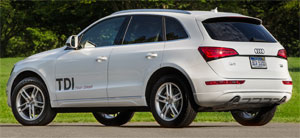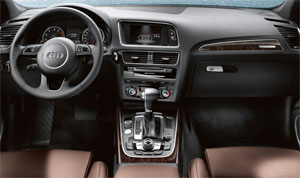2014 Audi Q5 TDI
The entire automotive industry is working feverishly on alternative fuel vehicles with electric and hydrogen powertrains. But, engineers are also working just as hard to improve the efficiency of traditional internal combustion engines. So, with ever higher mpg mandates ahead, clean diesels are becoming a lot more common, especially in utilities, like this Audi Q5 TDI. So, let’s see if this diesel ute is one Americans can love.
What is it about turbo diesels like this 2014 Audi Q5 TDI that we love so much? It’s certainly not the smell or more expensive cost of the diesel fuel. Perhaps it’s their simplicity as a higher mileage option, or that ability to fulfill our long range ambitions?
Or maybe it’s just that huge hit of torque you get when you stomp on the pedal. It’s a highly addictive response, and once you’ve sampled it, driving a gasoline powered equivalent is just not the same.
The Q5, Audi’s smallest crossover here for now, got a styling refresh just last year. But Audi saved the best updates for this year, a high performance SQ5 and our high miler TDI.
 The 3.0-liter turbocharged clean diesel V6 is the same 240-horsepower engine that we loved so much in the larger A8 sedan. But there’s even more to love in the Q5 as torque is up 22 lb-ft. to 428. Helping the high mileage cause is an 8-speed automatic transmission, and the combination is good for a towing capacity of 4,400-pounds.
The 3.0-liter turbocharged clean diesel V6 is the same 240-horsepower engine that we loved so much in the larger A8 sedan. But there’s even more to love in the Q5 as torque is up 22 lb-ft. to 428. Helping the high mileage cause is an 8-speed automatic transmission, and the combination is good for a towing capacity of 4,400-pounds.
All Q5s come equipped with the same quattro all-wheel-drive formula found in Audi sedans and SUV’s for years, rear bias and all; and is as much about handling performance as it is about all-weather capability. Though we put the latter to test through a few weeks of what has been a very cold and snowy winter here in the Mid-Atlantic. We had no issues finding traction even in deep snow; a testament to both the quattro’s abilities and the TDI’s low RPM nature.
All of that white stuff did keep us from taking the TDI to our test track, but Audi claims a 0-60 time of 6.5-seconds and our informal clocking concurs.
As for the recently updated design, the Q5 is truly a modern Audi, from the large Singleframe grille to the LED DRL’s that started the whole phenomenon. 19-inch wheels come standard on the TDI with 235/55 all-season tires.
Both commute time ride, and weekend getaway handling are quite good. But if you’re looking to get the most out of it in the performance department, make sure you have the crossbars removed from the roof rails; as when they are in place, the ESC adjusts parameters for a higher center of gravity. That’s pretty trick!
 Steering is electro-mechanical and felt very natural. Government Fuel Economy Ratings come in at 24-City, 31-Highway, and 27-Combined. We managed a quite good 29.4 miles per gallon. The Energy Impact Score is average for all vehicles at 14.1-barrels of oil used and 6.4 tons of CO2 emitted annually.
Steering is electro-mechanical and felt very natural. Government Fuel Economy Ratings come in at 24-City, 31-Highway, and 27-Combined. We managed a quite good 29.4 miles per gallon. The Energy Impact Score is average for all vehicles at 14.1-barrels of oil used and 6.4 tons of CO2 emitted annually.
You’ve heard our rave reviews before about recent Audi interiors, and the Q5 does nothing to dampen our fondness for the high quality materials, simplicity of design, and ease of use of its many high tech features; including the updated MMI Navigation Plus system.
Front seats are very supportive and comfortable, and there’s good room for 3 in the back seat. All passenger’s get plenty of light thanks to the standard panoramic sunroof. Cargo space is 29.1 cubic-ft. with rear seat backs in place, but expands to 57.3 cubic-ft. with them folded.
It’s not all good news, however; as a TDI Q5 will cost you $47,395. That’s almost 10-grand over a base Q5 which starts at $38,195. Our tester, with options, was over 50-grand.
Is the TDI worth all of that extra coin? Well truth be told, our SUV money would probably go elsewhere as there are a lot of mid and even full-size choices for that kind of money. Although, if you’re even contemplating stepping up to a turbo diesel, but are hesitant due to price; our advice is don’t even test drive one. Because, once you get a taste of all the torque that the 2014 Audi Q5 TDI has to offer, you might get addicted too.
Specifications
- Engine: 3.0-liter
- Horsepower: 240
- Torque: 428 lb-ft.
- 0-60 mph: 6.5 seconds
- EPA: 24 mpg city/ 31 mpg highway
- Energy Impact: 14.1 barrels of oil/yr
- CO2 Emissions: 6.4 tons/yr
2025 Volkswagen ID. Buzz
Volkswagen Brings Beetlemania Level Of Excitement To Minivan Segment
The duty of upholding Volkswagen’s heritage has most recently been delegated to small legacy car names like Golf and Jetta. But hold on! A much larger, totally modern take on VW’s classic microbus has just buzzed over the horizon— the all-electric ID. Buzz. It’s been at the top of our minds since we first saw the concept back in 2017. Well, it’s finally here, so let’s get our groove into drive!
This 2025 Volkswagen ID. Buzz has indeed created the most buzz around Volkswagen since the Beetle’s return to the U.S. in the late 1990s. We couldn’t drive it anywhere without drawing a crowd. No wonder, just about everyone has a VW Microbus story to tell, and seeing this reimagined version rolling down the street brings back all those memories.
VW really pulled it off as far as we’re concerned, as it looks great without appearing over the top. All the cues are here: Big VW logo front and center, lots of greenhouse including A-pillar windows and mini sliders for the second-row passengers, D-pillar air vents, and two-tone wheels. And while its appearance may be pure retro, its drivetrain is far from it, as the ID. Buzz is all-electric, and unlike the new Beetle, the Buzz does retain the original Microbus’ rear-drive architecture.
Powering those rear wheels is a 210-kW motor drawing juice from a 91-kWh battery for a range of 234 miles; 200-kW max charging will get you to 80% in about 26 minutes. Buyers can add another small 80-kW motor up front for 4motion all-wheel-drive and an increase of total output from 282 to 335 horsepower with a combined 512 lb-ft of torque. It uses the same battery, but range estimates drop just slightly to 231 miles. But while those numbers are modest, we also found them to be quite conservative, as we observed as many as 287 miles available in our all-wheel-drive tester’s gauge display and were on pace for 273 miles in our driving loop.
One throwback theme that may be a turnoff to some is that it’s quite a step up into the Buzz’s front seats, but there’s certainly a commanding view of the road once you climb in. Second row seating can be either a three-place bench or a pair of captain’s chairs, so there’s generous room for seven or six passengers. The captain’s chairs in our Pro S Plus offer good support and very easy access to the third row.
Lots of flexibility too with the option to simply fold the seats or remove them altogether.
With the sliding side doors and a wide opening rear hatch, there’s plenty of access for loading big sport utility amounts of cargo. Lots of flexibility too with the option to simply fold the seats or remove them altogether, and the ability to create a full-length flat floor with a rear cargo shelf that covers some handy removable storage bins. There’s 18.6 cubic-feet of space behind the third row, 75.5 behind the second, and a max of 145.5. That’s more than a Chevrolet Tahoe. For smaller items, there are lots of cubbies throughout the cabin, along with a standard Buzz Box that can be moved to multiple locations.
With a design that prioritizes retro form and modern function over aero efficiency, the 4motion equipped ID. Buzz earns a Fair efficiency rating, using 42-kWh of electricity per 100 miles, and we weren’t sure what to expect at our Mason Dixon test track.
What we found was great torque off the line and drama free launches to 60 in just 5.3 seconds. It was very stable at speed and power delivery stayed steady most of the way down the track until we reached about 90 mph, when it began to taper off just before we finished the quarter-mile in 14.0 seconds flat at 97 mph.
With 1,200-lbs. of battery weight nestled in its 127.5-inch wheelbase, the Buzz felt planted to the pavement through our handling course. There was quite a bit of body roll to deal with, but surprisingly little understeer. In panic braking runs, pedal response was inconsistent, feeling soft at times, pushing back hard at others; but through it all, results were quite good, stopping from 60 in an average of just 108 feet.
Three interior themes are available, this Dune is the brightest, featuring coastal inspired wood optic dash décor, “gray and clay” leatherette surfaces, and a high-mounted central 12.9-inch touchscreen. Pricing starts with a rear-wheel-drive Pro S at $61,545; this Pro S Plus begins at $65,045, add another $4,500 for 4motion, which brings a few extra features along with all-wheel drive.
Retro design with old-school VW charm, modern EV drivetrain, big SUV capacity merged with minivan flexibility; it all comes together in this 2025 Volkswagen ID. Buzz. It’s easily one of the coolest rides of the year and one that will likely keep Volkswagen dealers buzzing for years to come, and that’s something no other people and things mover can say.
Specifications
As Tested
- Motor Setup: Dual-Motor AWD
- Battery Size: 91-kWh
- Horsepower: 335
- Torque: 512 lb-ft
- EPA Range: 231 miles
- 0-60 mph: 5.3 seconds
- 1/4 Mile: 14.0 seconds at 97 mph
- Braking, 60-0: 108 feet
- MW Test Loop: ~ 273 miles













































